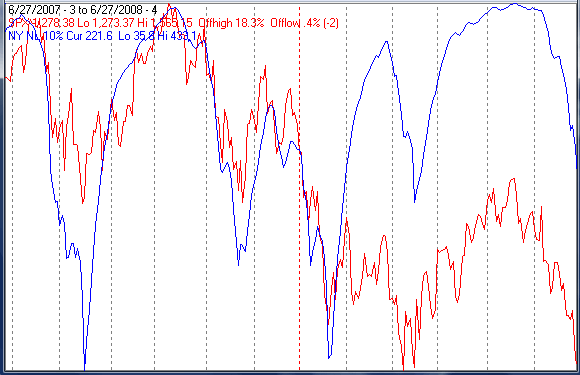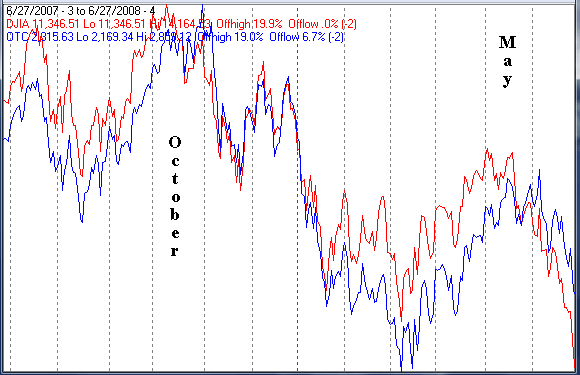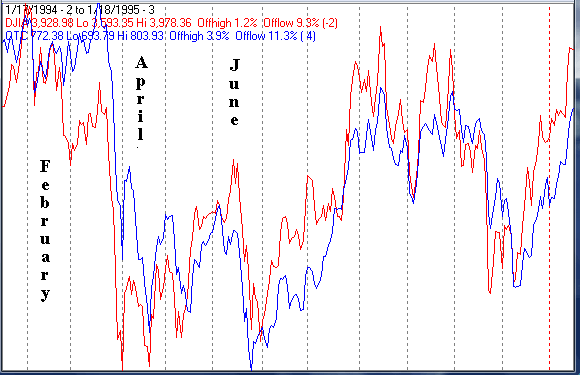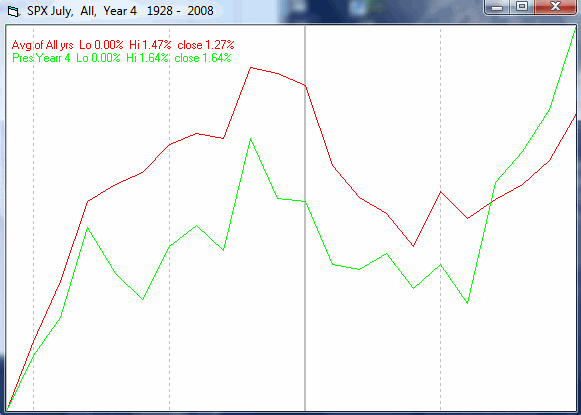Stock Markets Very Oversold Rally Expected Next Week
Stock-Markets / US Stock Markets Jun 29, 2008 - 12:48 PM GMTBy: Mike_Burk
The good news is: The market is very oversold and likely to bounce.
Short Term For the 1st 3 days of last week the DJIA danced slightly above its March low. Thursday and Friday it lost nearly 4% and the NYSE recorded 492 new lows, better than the 759 new lows recorded at the March low, but still enough to make another retest likely.
The DJIA has been down 8 out to the last 10 trading days so it is oversold and due to bounce.
The chart below covers the past year showing the S&P 500 (SPX) in red and a 10% trend (19 day EMA) of NYSE new lows (NY NL) in blue. NY NL has been plotted on an inverted Y axis so decreasing new lows move the indicator upward(up is good.
Little upward jogs in NY NL should be ignored.
A good rule of thumb is to wait for indicator to move upward for 5 consecutive days before considering the possibility of a trend change.

Intermediate Term
I have often stated that the secondaries lead both up and down. That has not been the case since last October. The last time we saw the blue chips lead the way down was 1994 also the time of the last fixed income "crisis". An explanation given at the time was financial companies had to sell some of their blue chip stock holdings to cover their fixed income losses. That scenario fits today.
The chart below covers the past year showing the Dow Jones Industrial Average(DJIA in red and the NASDAQ composite(OTC)in blue. Dashed vertical lines have been drawn on the 1st trading day of each month.
The DJIA peaked in early October while the OTC peaked at the end of the month, both rallied from the March lows and again the DJIA peaked a week or two ahead of the OTC in May.

The next chart is similar to the one above except it covers the period from January 1994 to January 1995.
The DJIA peaked in early February while the OTC peaked in late March, about 6 weeks later. The DJIA hit a low on April 4 of 3,593; there were 637 new lows on the NYSE and 387 on the NASDAQ. On April 20, 1994 the DJIA retested its low hitting 3,598; there were 168 new lows on the NYSE and 251 on the NASDQ. The OTC hit its low for the decline on June 24; there were 143 new lows on the NYSE and 238 on the NASDAQ.

Fixed income problems appear to be more damaging to the blue chips than the secondaries. The examples are rare enough that we cannot draw many conclusions.
Seasonality
Next week includes the last trading day of June and the 1st 3 trading days of July during the 4th year of the Presidential Cycle.
The tables show the daily return on a percentage basis for the last trading day of June and the 1st 3 trading days of July during the 4th year of the Presidential Cycle. OTC data covers the period from 1963 - 2007 and SPX data from 1928 - 2007. There are summaries for both the 4th year of the Presidential Cycle and all years combined.
By all measures the coming week has had, on average positive returns.
Last day of June and first 3 days of July.
The number following the year represents its position in the presidential cycle.
The number following the daily return represents the day of the week;
1 = Monday, 2 = Tuesday etc.
| OTC Presidential Year 4 | |||||
| Day1 | Day1 | Day2 | Day3 | Totals | |
| 1964-4 | -0.05% 2 | 0.07% 3 | 0.62% 4 | 0.20% 1 | 0.85% |
| 1968-4 | -0.22% 5 | 0.12% 1 | 0.36% 2 | 0.46% 3 | 0.72% |
| 1972-4 | 0.56% 5 | 0.39% 1 | 0.53% 3 | 0.44% 4 | 1.93% |
| 1976-4 | 0.23% 3 | -0.04% 4 | 0.66% 5 | -0.29% 2 | 0.57% |
| 1980-4 | -0.88% 1 | 0.25% 2 | 0.64% 3 | 1.06% 4 | 1.07% |
| 1984-4 | 0.56% 5 | -0.73% 1 | 0.16% 2 | -0.19% 4 | -0.20% |
| Avg | 0.05% | 0.00% | 0.47% | 0.30% | 0.82% |
| 1988-4 | 0.77% 4 | 0.01% 5 | 0.36% 2 | -0.17% 3 | 0.97% |
| 1992-4 | 0.86% 2 | 0.96% 3 | -0.99% 4 | -0.03% 1 | 0.79% |
| 1996-4 | 1.63% 5 | 1.05% 1 | -0.52% 2 | -0.81% 3 | 1.35% |
| 2000-4 | 2.29% 5 | 0.65% 1 | -3.23% 3 | 2.52% 4 | 2.24% |
| 2004-4 | 0.63% 3 | -1.57% 4 | -0.44% 5 | -2.15% 2 | -3.54% |
| Avg | 1.24% | 0.22% | -0.96% | -0.13% | 0.36% |
| OTC summary for Presidential Year 4 1964 - 2004 | |||||
| Averages | 0.58% | 0.10% | -0.17% | 0.10% | 0.61% |
| % Winners | 73% | 73% | 64% | 45% | 82% |
| MDD 7/6/2004 4.12% -- 7/5/2000 3.23% -- 7/3/1996 1.32% | |||||
| OTC summary for all years 1963 - 2007 | |||||
| Averages | 0.26% | 0.04% | -0.15% | 0.03% | 0.18% |
| % Winners | 64% | 58% | 53% | 49% | 56% |
| MDD 7/2/2002 7.20% -- 7/6/1981 4.18% -- 7/3/1974 4.13% | |||||
| SPX Presidential Year 4 | |||||
| Day1 | Day1 | Day2 | Day3 | Totals | |
| 1928-4 | 0.26% 6 | -1.09% 1 | 1.63% 2 | 0.98% 4 | 1.79% |
| 1932-4 | -1.77% 4 | 3.84% 5 | -2.17% 2 | 2.22% 3 | 2.11% |
| 1936-4 | -0.34% 2 | 0.40% 3 | -0.13% 4 | 0.94% 5 | 0.88% |
| 1940-4 | 0.00% 6 | -1.10% 1 | -0.20% 2 | 0.30% 3 | -1.00% |
| 1944-4 | 0.31% 5 | 0.08% 6 | 0.92% 1 | 0.53% 3 | 1.84% |
| Avg | -0.31% | 0.42% | 0.01% | 1.00% | 1.12% |
| 1948-4 | 0.30% 3 | -0.24% 4 | 0.90% 5 | 0.00% 2 | 0.96% |
| 1952-4 | 0.52% 1 | 0.64% 2 | -0.24% 3 | -0.04% 4 | 0.89% |
| 1956-4 | -0.34% 5 | -0.09% 1 | 0.83% 2 | 1.01% 4 | 1.42% |
| 1960-4 | -0.04% 4 | 0.25% 5 | -0.07% 2 | -0.14% 3 | 0.00% |
| 1964-4 | 0.06% 2 | 0.71% 3 | 0.40% 4 | 0.46% 1 | 1.63% |
| Avg | 0.10% | 0.25% | 0.36% | 0.26% | 0.98% |
| 1968-4 | -0.40% 5 | -0.18% 1 | 0.34% 2 | 1.17% 3 | 0.93% |
| 1972-4 | 0.30% 5 | 0.33% 1 | 0.57% 3 | 0.87% 4 | 2.06% |
| 1976-4 | 0.40% 3 | -0.66% 4 | 0.50% 5 | -0.55% 2 | -0.30% |
| 1980-4 | -1.52% 1 | 0.60% 2 | 0.65% 3 | 1.54% 4 | 1.28% |
| 1984-4 | 0.22% 5 | 0.01% 1 | 0.33% 2 | -0.61% 4 | -0.05% |
| Avg | -0.20% | 0.02% | 0.48% | 0.48% | 0.78% |
| 1988-4 | 0.93% 4 | -0.63% 5 | 1.48% 2 | -1.37% 3 | 0.41% |
| 1992-4 | -0.20% 2 | 1.16% 3 | -0.27% 4 | 0.50% 1 | 1.20% |
| 1996-4 | 0.31% 5 | 0.78% 1 | -0.34% 2 | -0.18% 3 | 0.58% |
| 2000-4 | 0.85% 5 | 1.01% 1 | -1.57% 3 | 0.73% 4 | 1.01% |
| 2004-4 | 0.41% 3 | -1.04% 4 | -0.32% 5 | -0.81% 2 | -1.76% |
| Avg | 0.46% | 0.26% | -0.20% | -0.23% | 0.29% |
| SPX summary for Presidential Year 4 1928 - 2004 | |||||
| Averages | 0.01% | 0.24% | 0.16% | 0.38% | 0.79% |
| % Winners | 60% | 60% | 55% | 60% | 80% |
| MDD 7/5/1932 2.17% -- 7/6/2004 2.16% -- 7/5/2000 1.57% | |||||
| SPX summary for all years 1928 - 2007 | |||||
| Averages | 0.13% | 0.31% | 0.25% | 0.32% | 1.00% |
| % Winners | 57% | 70% | 62% | 59% | 73% |
| MDD 7/2/2002 4.30% -- 7/6/1981 3.43% -- 7/5/1973 2.78% | |||||
Money supply (M2)
The chart below was provided by Gordon Harms. Money supply growth has remained near its lowest levels in years.

July
Since 1963 the OTC has been up 49% of the time in July and had an average loss of 0.2% making it the worst month of the year for that index.
During the 4th year of the Presidential Cycle the OTC has been up 36% of the time with an average loss of 1.5%. The 1.5% average loss is second to March's 2.0% average loss while the 36% up percentage is the worst of any month in the 4th year. The worst July ever for the OTC, 1996 down 9.8%; the best July ever for the OTC 1997 up 10.8%
The average month has 21 trading days. The charts below are calculated by averaging the daily return of the 1st 11 trading days and the last 10. A dashed vertical line has been drawn at the 1st trading day and at 5 trading day intervals after that, the vertical line is solid at the 11th trading day, the dividing point. When there have been more than 21 trading days, some of the days in the middle have been ignored. When there have been less than 21 trading days some of the days in the middle have been counted twice.
The 1st chart shows the average of the OTC over all years in blue and for the 4th year of the Presidential Cycle in green.

Since 1928 the SPX has been up 58% of the time in July and had an average gain of 1.1% making it the 4th best month of the year after December, January and April.
During the 4th year of the Presidential Cycle the SPX has been up 50% of the time making it the worst month of the year by that measure, but the average gain has been 1.9% second only to August's 2.9% average gain. The 1.9% average gain was enhanced considerably by a 32.6% gain in 1932. The July 1932 gain is second to the 37.3% gain recorded in August of 1932, the following month. The worst July ever for the SPX, 1933 down 11.1%.
The chart below shows the average of the SPX over all years in red and for the 4th year of the Presidential Cycle in green.

Conclusion
The March lows did not provide support for the DJIA and new lows rose to levels that suggest more downside movement. The market is oversold and seasonal end of month / beginning of month as well as a day or two ahead of holidays should provide some seasonal support next week.
I expect the major indices to be higher on Friday July 3 than they were on Friday June 27.
Last weeks positive forecast based on an oversold market hitting support was a miss.
By Mike Burk
To subscribe to this report : http://alphaim.net/signup.html
Gordon Harms produces a Power Point for our local timing group. You can get a copy of that at: http://www.stockmarket-ta.com/ .
Disclaimer: Mike Burk is an employee and principal of Alpha Investment Management (Alpha) a registered investment advisor. Charts and figures presented herein are believed to be reliable but we cannot attest to their accuracy. Recent (last 10-15 yrs.) data has been supplied by CSI (csidata.com), FastTrack (fasttrack.net), Quotes Plus (qp2.com) and the Wall Street Journal (wsj.com). Historical data is from Barron's and ISI price books. The views expressed are provided for information purposes only and should not be construed in any way as investment advice. Furthermore, the opinions expressed may change without notice.
Mike Burk Archive |
© 2005-2022 http://www.MarketOracle.co.uk - The Market Oracle is a FREE Daily Financial Markets Analysis & Forecasting online publication.




